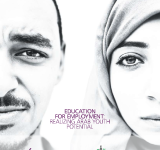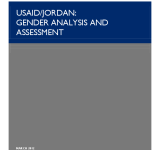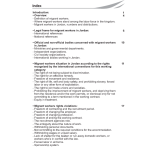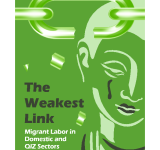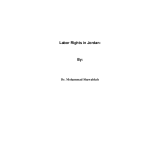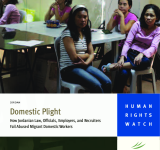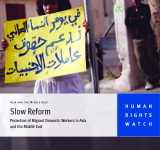employer
The report presents an up-to-date analysis of gender disparities in Jordan to inform development assistance programs by the USAID for the 2013-2017 strategic plan. The assessment report is prepared by the Global Health Technical Assistance Project;; funded by USAID Jordan and therefore;; it is based on a literature review and field work of the 21 focus group discussions held in Amman;; Irbid;; Tafileh and Zarqa. The report establishes that Jordan has begun to transition to a knowledge-based economy with the national advantage as its people. It also points out that despite the investments that have helped address gender equality issues;; Jordan continues to bear low female participation in the labor markets;; gender stereotypes about the role of females and males and conservative cultural norms. The report includes a sector-by-sector analysis;; recommendations;; gender review and an illustrative implementation plan. It concludes with key recommendations on the wide breadth of the USAID Jordan portfolio with a key emphasis on gender issues.
The migrant worker in Jordan situation report was issued in 2009. It presents an overview of the situation of migrant workers in Jordan and the main violations they are subject to. Additionally;; the report offers recommendations to national and international parties concerned with the migrant workers' rights.
This report is the second annual report of Tamkeen Center for Legal Aid and Human Rights. It addresses the status of both migrant domestic workers and migrant workers in Qualified Industrial Zones because these two categories are subject to recurrent abuses and are the most vulnerable group due to legislative reasons;; administrative practices and the actions of their employers.
This paper aims at shedding light on the labor rights in Jordan;; particularly for those who are working in the informal sector;; through identifying the factors that impede them from enjoying such rights and;; thus;; coming up with the appropriate recommendations in this area.
يوثّق التقرير الانتهاكات القائمة بحق عاملات المنازل;; وإخفاق المسؤولين الأردنيين في محاسبة أرباب العمل ومكاتب الاستقدام التي تستقدم العاملات. كما ينتقد التقرير قوانين الهجرة وقوانين العمل المنزلي التي تيسّر وقوع الانتهاكات;; من قبيل تحديد الإقامة قسراً في البيت وفرض غرامات على تجاوز مدد الإقامة القانونية;; حتى إن لم تكن العاملة هي السبب في التجاوز.
يراجع التقرير أوضاع ثماني دول فيها أعداد كبيرة من عاملات المنازل المهاجرات;; هي لبنان والأردن والسعودية والكويت والإمارات والبحرين وسنغافورة وماليزيا. يعرض التقرير التقدم المحرز في توفير تدابير الحماية المتوفرة بموجب قوانين العمل لعاملات المنازل;; وإصلاح نظم "الكفالة" الخاصة بالهجرة والتي تسهم في الإساءة للعاملات;; وضمان فعالية استجابة الشرطة والمحاكم على العنف البدني والجنسي;; والسماح للمجتمع المدني والنقابات بالتنظيم.
يتضمن هذا التقرير تحليلاً موسعاً ومتكاملاً لمؤشرات الفقر بالاستناد الى بيانات مسح نفقات ودخل الأسرة لعام 2008;; الذي نفذته دائرة الاحصاءات العامة على أربع جولات ميدانية استمرت سنة;; والذي انتهى العمل به مع نهاية الربع الأول لعام 2009. وبناءاً على بيانات هذا المسح تم اعداد تقريرين سابقين: الأول كان فيه عرض للنتائج الرئيسية للمسح والآخر تناول قياس مؤشرات الفقر باستخدام منهجية السعرات الحرارية المعتمدة من قبل البنك الدولي ومقارنتها عبر الزمن بالأسعار الثابتة. وبناءاً عليه تم تم اعداد هذا التقرير التحليلي لحالة الفقر في الأردن;; وذلك بمشاركة العديد من الجهات الوطنية المعنية بالفقر. وكما يتناول التقرير تحليلاً للتدخلات الحكومية المباشرة بالأسعار الجارية خلال عام 2008 في الحد من ظاهرة الفقر.
